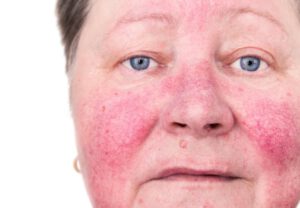Genetic variants associated with the severity of symptoms of the chronic skin condition, rosacea, have been identified for the first time in a new study. Despite rosacea affecting more than 16 million people in the United States alone, the cause of the common condition is unknown. 
Symptoms of rosacea can include flushing and persistent redness, in its more mild form, to pimple-like pustules that appear on the face. More severe cases include a thickening of the skin and an enlargement of the nose. Rosacea is three times more likely to affect women as it is men, but men tend to experience more severe symptoms.
This new study, published earlier this year in Human Molecular Genetics, found seven gene regions associated with symptom severity that play a role in skin pigmentation, immune response, and inflammation. The findings give new insight into the underlying biology of the disease and may hold clues for identifying drug targets used to treat it, according to the researchers at GlaxoSmithKline who collaborated with 23andMe to conduct this research.
“Most genetic studies focus on genetic factors that affect disease risk by comparing people with and without disease,” said Matt Nelson, head of Genetics at GlaxoSmithKline. “The 23andMe survey data allowed us to investigate disease severity in people who have rosacea, identifying potential targets for drugs that can reverse the symptoms of disease. This approach may be crucial for developing better drugs for treating chronic diseases.”
Three years ago, 23andMe and researchers at Stanford conducted the first genome-wide association study of rosacea risk. This latest study focuses on understanding rosacea symptom severity and is more than three times larger.
The scientists at GlaxoSmithKline, with support from the PAREXEL Genomic Medicine team, used data from more than 73,000 23andMe customers who consented to participate in research. The participants were of mostly European ancestry and answered questions about symptoms associated with rosacea. Scientists still don’t fully understand what causes the condition, but this study and others give vital clues as to the genes involved which was previously unknown.
Beyond the findings themselves, the study highlights the power of 23andMe’s research model.
“This is a good example of how the 23andMe research model can lead to discoveries for common but understudied conditions. It would be very difficult and expensive to conduct a traditional genetic study of rosacea on this scale,” said 23andMe Research Fellow and Statistical Genetics David Hinds.